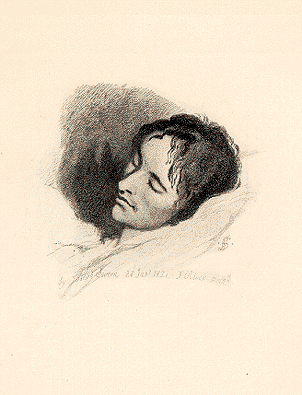
John Keats (1795-1821)
Things to Consider:
-
Negative Capability
-
Role of Nature
-
Role of Art
-
Imagination
-
Ode

-
Apostrophe

** Homework Questions ** (See Questions for "Fall of Hyperion"  )
)
922:
-
What is "negative capability"? See also 994.
-
What is the "egotistical sublime"? See also 1000.
"Ode to a Nightingale" (1819)
On-line version (w/ good notes  )
)
-
How does this poem compare with Percy Shelley's "To a Skylark"?
953-54:
-
What does the speaker long to forget?
954:
-
Why "seems it rich to die" (55)?
955:
-
Explain: "The fancy cannot cheat so well / As she is fam'd to
do" (73-4).


 See other examples
See other examples 
"Ode on a Grecian Urn" (1819)
On-line version (w/ good notes  )
)
-
How does this poem compare to Shakespeare's Sonnet #18?
956:
-
Why are unheard melodies sweeter than heard ones (11-12)?
-
Explain: "She cannot fade, though thou hast not thy bliss, / For
ever wilt thou love and she be fair" (19-20).
957:
-
Explain: "Beauty is truth, truth beauty,--that is all / Ye know
on earth, and all ye need to know" (49-50).
Other Discussion Questions:
953:
-
What is hemlock (2)? Why does the speaker feel as if he has drunk
it?
-
What is Lethe (4)?

-
What is vintage (11)?
-
What is the "blushful Hippocrene" (16)?

955:
-
Who is Ruth (66)?

More Complex Questions:
(Source: McGraw-Hill Guide to English Literature, vol.
2)
-
Why does the speaker say that the urn "canst thus express / A flowery
tale more sweetly than our rhyme" (3-4)? Explain what this means
and how it might be so.
-
This poem is an apostrophe to an inanimate object. How does this
rhetorical device function in this poem?
-
In the ode, the speaker establishes a contrast between life as it is
represented on the urn and life as it is lived. What is the nature
of this contrast, and where does it surface in this poem?
"The Fall of Hyperion: A Dream"
(1819)
978:
-
Who are Hyperion, Apollo, Mnemosyne and Saturn?
-
Why did Keats give up the Hyperion project?
Canto One:
978-79:
-
Explain the "induction" found in the first 18 lines.
980-81:
-
Describe the imagery presented in 1.59-92.
981:
-
Explain the challenge the speaker is given in 1.107-8.
982:
-
Why is the speaker alone (1.160)?
983:
-
Explain the discussion of the vulture and the eagle (1.191-92).
-
What, according to the "shade", is the difference between a poet
and a dreamer?
985:
-
What is the "Omega of a wither'd race" (1.288)?
Canto Two:
989-90:
-
Who is speaking in 2.1-49?
Other Discussion Questions:
984:
-
Who is Moneta?
-
Explain 1.244-48.
985:
-
What is an "immortal sickness" (1.258)?
987:
-
Who is Thea? Why does she wake Saturn (1.354ff)?
-
What literary technique is employed in 1.372-78? How is the use of this
technique significant, if at all?
988:
-
For how long does the speaker stay looking at the three motionless figures
of Moneta, Thea, and Saturn? Why?
-
Who is Cybele?
Back to Top


 See other examples
See other examples